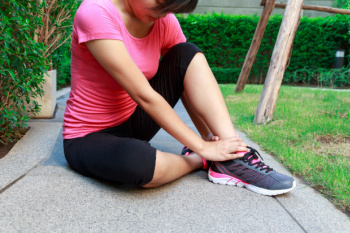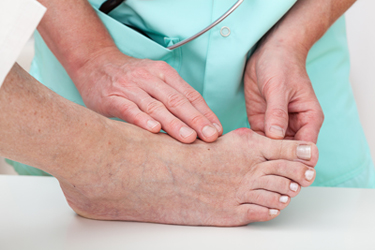

Ankle sprains are one of the most common injuries in sports, often caused by quick movements, uneven surfaces or improper landings. Athletes can reduce their risk by building ankle strength and improving balance through simple exercises. A proper warm-up before training and a cool-down after help prepare the muscles and reduce stiffness. Supportive footwear that fits well and suits the activity provides important protection. Bracing or taping may also help if the ankle is weak or has been injured before. Training on stable ground and avoiding sudden changes in intensity lowers the chance of twisting or rolling the ankle. Resting at the first sign of discomfort can stop a small issue from becoming a serious injury. If your ankle swells, bruises, or feels unstable, it is suggested you see a podiatrist for a diagnosis and appropriate treatment.
Ankle and foot injuries are common among athletes and in many sports. They can be caused by several problems and may be potentially serious. If you are feeling pain or think you were injured in a sporting event or when exercising, consult with Dr. Randy Garr from Bigfoot Podiatry. Our doctor will assess your condition and provide you with quality foot and ankle treatment.
Common Injuries
The most common injuries that occur in sporting activities include:
- Achilles Tendonitis
- Achilles Tendon Rupture
- Ankle Sprains
- Broken Foot
- Plantar Fasciitis
- Stress Fractures
- Turf Toe
Symptoms
Symptoms vary depending upon the injury and in some cases, there may be no symptoms at all. However, in most cases, some form of symptom is experienced. Pain, aching, burning, bruising, tenderness, tightness or stiffness, sensation loss, difficulty moving, and swelling are the most common symptoms.
Treatment
Just as symptoms vary depending upon the injury, so do treatment options. A common treatment method is known as the RICE method. This method involves rest, applying ice, compression and elevating the afflicted foot or ankle. If the injury appears to be more serious, surgery might be required, such as arthroscopic or reconstructive surgery. Lastly, rehabilitation or therapy might be needed to gain full functionality in the afflicted area. Any discomfort experienced by an athlete must be evaluated by a licensed, reputable medical professional.
If you have any questions, please feel free to contact our office located in Provo, UT . We offer the newest diagnostic and treatment technologies for all your foot care needs.

When bunions cause significant pain or disrupt everyday activities, surgery may be recommended after other treatment options have been attempted. A podiatrist can evaluate the severity of the bunion and explain whether surgery is warranted. Bunion surgery can offer pain relief, improved alignment, and better stability, but it also involves potential risks. Some surgical options involve removing bone, reshaping the joint, or fusing bones to limit movement and prevent the bunion from returning. Results can depend heavily on the severity of the bunion, the specific procedure used, and how well the foot heals. Risks include infection, nerve damage, joint stiffness, and the possibility that the bunion could recur. Some patients may also experience reduced toe flexibility or have problems wearing certain types of shoes following surgery. If bunions are interfering with your daily activities, it is suggested that you schedule an appointment with a podiatrist to find out if surgery is an option for you.
Foot surgery is sometimes necessary to treat a foot ailment. To learn more, contact Dr. Randy Garr of Bigfoot Podiatry. Our doctor will assist you with all of your foot and ankle needs.
When Is Surgery Necessary?
Foot and ankle surgery is generally reserved for cases in which less invasive, conservative procedures have failed to alleviate the problem. Some of the cases in which surgery may be necessary include:
- Removing foot deformities like bunions and bone spurs
- Severe arthritis that has caused bone issues
- Cosmetic reconstruction
What Types of Surgery Are There?
The type of surgery you receive will depend on the nature of the problem you have. Some of the possible surgeries include:
- Bunionectomy for painful bunions
- Surgical fusion for realignment of bones
- Neuropathy decompression surgery to treat nerve damage
Benefits of Surgery
Although surgery is usually a last resort, it can provide more complete pain relief compared to non-surgical methods and may allow you to finally resume full activity.
Surgical techniques have also become increasingly sophisticated. Techniques like endoscopic surgery allow for smaller incisions and faster recovery times.
If you have any questions please feel free to contact our office located in Provo, UT . We offer the newest diagnostic and treatment technologies for all your foot and ankle needs.

Gout is a form of inflammatory arthritis caused by the buildup of uric acid crystals in the joints. This buildup results from either overproduction of uric acid or the body’s inability to eliminate it properly. The condition often affects the big toe joint but can occur in other joints such as the ankles, knees, and wrists. The first sign of gout is usually sudden, intense pain in the affected joint, often starting at night. The joint may appear red, swollen, warm, and extremely tender to the touch. Even the light pressure from a bedsheet can be painful. Repeated gout attacks may lead to chronic joint damage if left untreated. If you have symptoms of gout, it is strongly suggested that you are under the care of a podiatrist who can help you to manage this painful condition.
Gout is a painful condition that can be treated. If you are seeking treatment, contact Dr. Randy Garr from Bigfoot Podiatry. Our doctor will treat your foot and ankle needs.
What Is Gout?
Gout is a form of arthritis that is characterized by sudden, severe attacks of pain, redness, and tenderness in the joints. The condition usually affects the joint at the base of the big toe. A gout attack can occur at any random time, such as the middle of the night while you are asleep.
Symptoms
- Intense Joint Pain - Usually around the large joint of your big toe, and it most severe within the first four to twelve hours
- Lingering Discomfort - Joint discomfort may last from a few days to a few weeks
- Inflammation and Redness -Affected joints may become swollen, tender, warm and red
- Limited Range of Motion - May experience a decrease in joint mobility
Risk Factors
- Genetics - If family members have gout, you’re more likely to have it
- Medications - Diuretic medications can raise uric acid levels
- Gender/Age - Gout is more common in men until the age of 60. It is believed that estrogen protects women until that point
- Diet - Eating red meat and shellfish increases your risk
- Alcohol - Having more than two alcoholic drinks per day increases your risk
- Obesity - Obese people are at a higher risk for gout
Prior to visiting your podiatrist to receive treatment for gout, there are a few things you should do beforehand. If you have gout you should write down your symptoms--including when they started and how often you experience them, important medical information you may have, and any questions you may have. Writing down these three things will help your podiatrist in assessing your specific situation so that he or she may provide the best route of treatment for you.
If you have any questions, please feel free to contact our office located in Provo, UT . We offer the newest diagnostic and treatment technologies for all your foot care needs.









